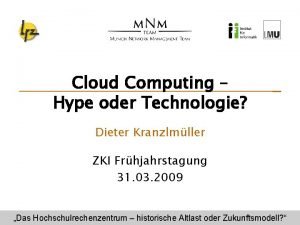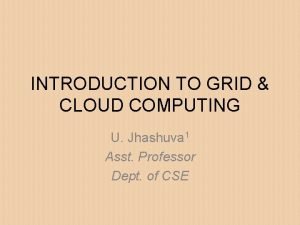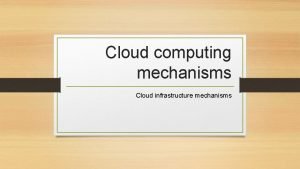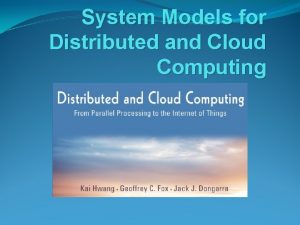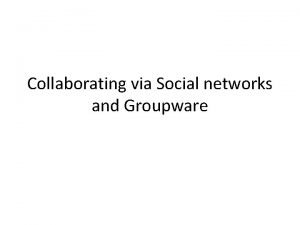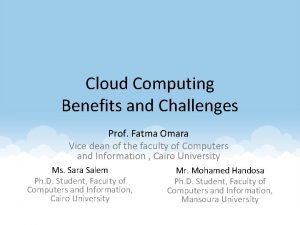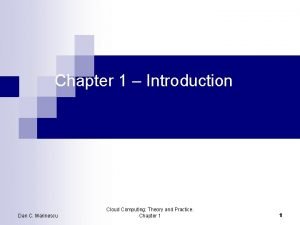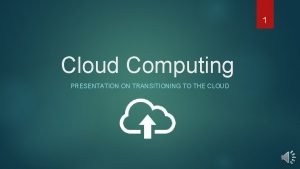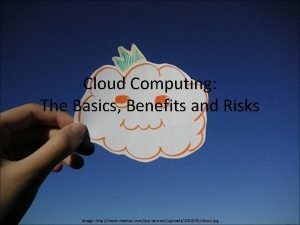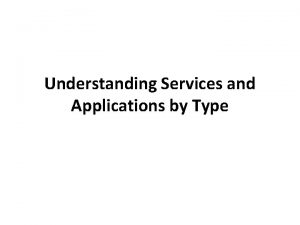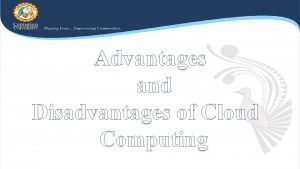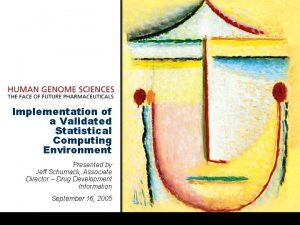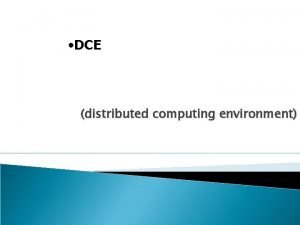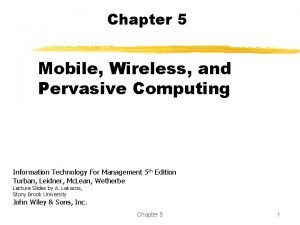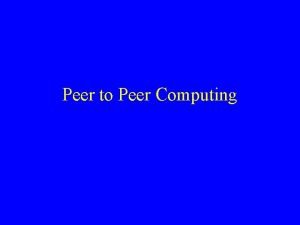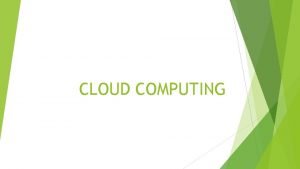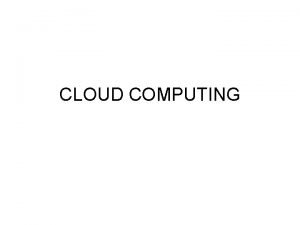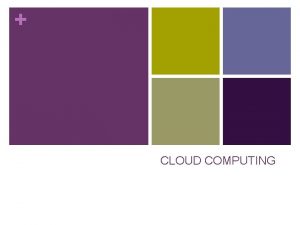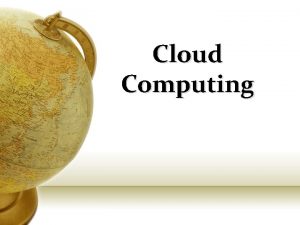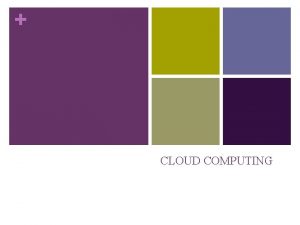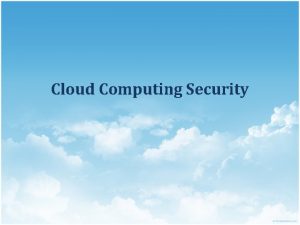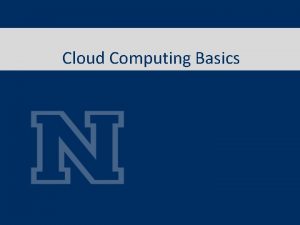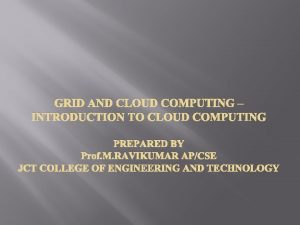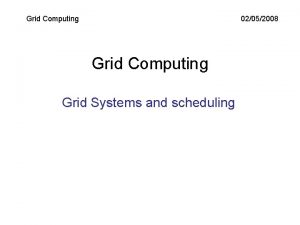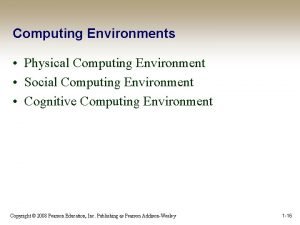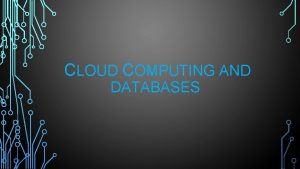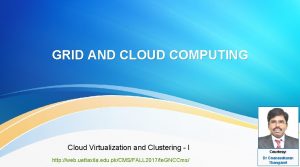Grid and Cloud Computing Grid ResourceSharing Environment Users



















- Slides: 19

Grid and Cloud Computing

Grid: Resource-Sharing Environment • Users: – 1000 s from 10 s institutions – Well-established communities • Resources: – Computers, data, instruments, storage, applications – Owned/administered by institutions • Applications: data- and compute-intensive processing • Approach: common infrastructure


Grid: Definitions • Definition 1: Infrastructure that provides dependable, consistent, pervasive, and inexpensive access to highend computational capabilities (1998) • Definition 2: A system that coordinates resources not subject to centralized control, using open, generalpurpose protocols to deliver nontrivial Quality of Service (2002)

Grid Computing • Grid computing is the ability to process information by utilizing a collection of networked heterogeneous informationprocessing components (hardware and software), all of which are provisioned from various geographical locations and across organizational boundaries. [5]

Cont. In grid computing the concept of Virtual Organizations (VOs) rises. Which means that all resources were owned by a single organization. Two key outcomes exist in grids: 1. The Open Grid Service Architecture (OGSA) 2. The Globus Toolkit. OGSA means how grids are created and maintained.

Cont. . • The Globus Toolkit is a software middleware package. All that is required is to install and configure Globus and then create all required resources and services. • grid security approach is the Grid Security Infrastructure (GSI) which has been implemented in • the Globus Toolkit

An Example: The Globus Toolkit - Initially developed at Argonne National Lab/University of Chicago and ISI/University of Southern California

How It Started While helping to build/integrate a diverse range of distributed applications, the same problems kept showing up over and over again. – Too hard to keep track of authentication data (ID/password) across institutions – Too hard to monitor system and application status across institutions – Too many ways to submit jobs – Too many ways to store & access files and data – Too many ways to keep track of data – Too easy to leave “dangling” resources lying around (robustness)

grid architecture in a nutshell

Forget Homogeneity! • Trying to force homogeneity on users is futile. Everyone has their own preferences, sometimes even dogma. • The Internet provides the model…

Cloud: just a new name for Grid? • Nevertheless YES: – Problems are the same in clouds and grids – Common need to manage large facilities – Define methods to discover, request and use resources – Implement highly parallel computations Grid Computing, MIERSI, DCC/FCUP 12

Cloud: just a new name for Grid? • YES: – Reduce the cost of computing – Increase reliability – Increase flexibility (third party) Grid Computing, MIERSI, DCC/FCUP 13

Cloud: just a new name for Grid? • NO: – Great increase demand for computing (clusters, high speed networks) – Billions of dollars being spent by Amazon, Google, Microsoft to create real commercial large-scale systems with hundreds of thousands of computers – www. top 500. org shows computers with 100, 000+ cores – Analysis of massive data Grid Computing, MIERSI, DCC/FCUP 14

Clouds: side-by-side comparison with grids Resource management • Compute model – Grids: batch-scheduled (queueing systems) – Clouds: resources shared by all users at the same time (? ? !) in contrast to dedicated resources in queueing systems – Maybe one of the major challenges in clouds: Qo. S! Grid Computing, MIERSI, DCC/FCUP 15

Clouds: side-by-side comparison with grids Resource management • Data model: – Grids: concept of virtual data, replica, metadata catalog, abstract structural representation – Data locality: to achieve good scalability data must be distributed over many computers – Clouds: use map-reduce mechanism like in Google to maintain data locality – Grids: rely on shared file systems (NFS, GPFS, PVFS, Lustre) Grid Computing, MIERSI, DCC/FCUP 16

Clouds: side-by-side comparison with grids Resource management • Virtualization: – Abstraction and encapsulation – Clouds: rely heavily on virtualization – Grids: do not rely on virtualization as much as clouds. One example of use in Grids: Nimbus (previous Virtual Workspace Service) Grid Computing, MIERSI, DCC/FCUP 17

Grid Projects • NAREGI ( National Research Grid Initiative) is a grid project that focuses on the research and development of grid middleware. • The test contains almost 3000 CPUs and is capable of 17 teraflops of processing power, offered from various research institutions throughout Japan. • BOINC is an Open-source software for volunteer computing and grid computing. • BOINC is supported by the National Science Foundation(SETI@home, Climateprediction. net)

Grid vs Cloud 1. Neither grids nor clouds have a commonly accepted definition. 2. Grids are publicly funded and operated, whereas clouds are privately funded and operated. 3. Grids and clouds are instantiations of distributed systems, which is a common feature of them. 4. Grids evolve slowly and clouds evolve fast, and The level of expertise to use a cloud is significantly lower than that of a grids.
 Grid and cloud computing lmu
Grid and cloud computing lmu Grid and cloud computing definition
Grid and cloud computing definition Polling agent in cloud computing
Polling agent in cloud computing A composable component must be modular
A composable component must be modular Conventional computing and intelligent computing
Conventional computing and intelligent computing Virtualization structures tools and mechanism
Virtualization structures tools and mechanism All resources are tightly coupled in computing paradigm of
All resources are tightly coupled in computing paradigm of Evaluating online groupware in cloud computing
Evaluating online groupware in cloud computing The land fatma omara
The land fatma omara Dan c. marinescu
Dan c. marinescu Cloud computing presentation slides
Cloud computing presentation slides Cloud computing benefits and risks
Cloud computing benefits and risks Pods aggregation and silos in cloud computing
Pods aggregation and silos in cloud computing Cloud computing places the processing and
Cloud computing places the processing and Disadvantages of grid computing
Disadvantages of grid computing Statistical computing environment
Statistical computing environment Dce in distributed system
Dce in distributed system Characteristics of mobile computing environment
Characteristics of mobile computing environment Peer to peer computing environment
Peer to peer computing environment Land grid array vs pin grid array
Land grid array vs pin grid array
